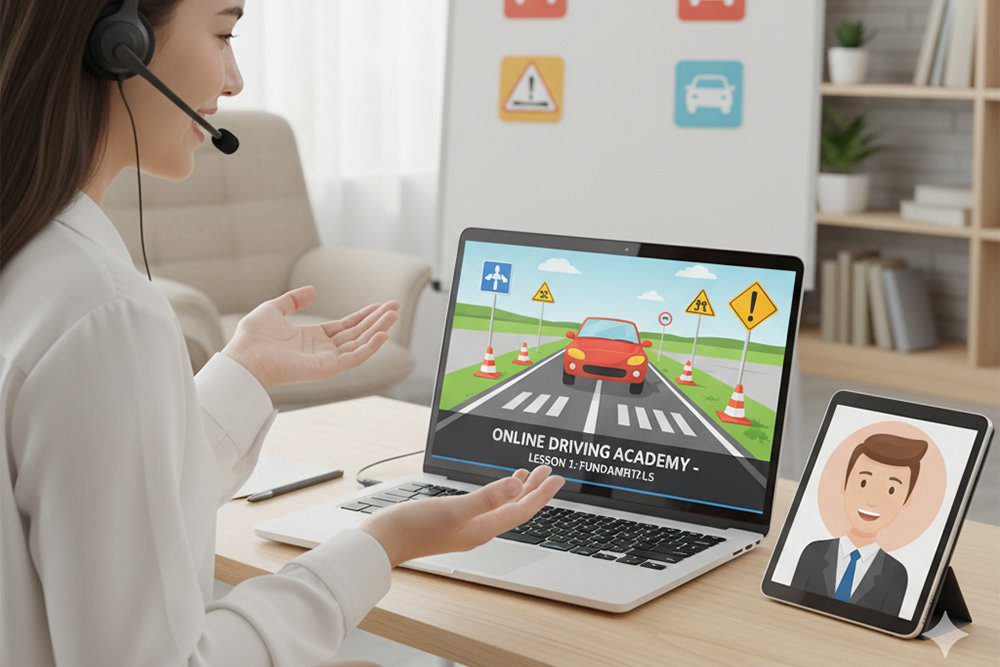Driver education in Canada has evolved more in the past five years than in the previous five decades. With the rise of technology, the convenience of virtual learning, and changing lifestyles, a new era has begun—one that challenges the traditional model of in-person instruction. The debate between online driving courses in Ontario and traditional in-person lessons is now at the heart of how young drivers, newcomers, and busy professionals approach learning to drive.
As we move toward a digital-first society, both learning formats have their advantages—and their challenges. Whether you’re preparing for your G1, G2, or G license, understanding the future of driver education means recognizing how these methods complement each other. Let’s explore how both options are reshaping the driving experience in Canada, what they mean for road safety, and how the modern driving school of 2025 and beyond is bridging the gap between physical and digital training.
1. The Digital Shift in Driver Education
Driver training has traditionally relied on in-person, instructor-led lessons. Students would attend classroom sessions for theory, then hit the road with an instructor to practice real-life driving. However, as digital education matured—especially during and after the pandemic—the demand for online driving courses in Ontario skyrocketed.
Today, platforms across the province allow learners to complete their mandatory classroom hours entirely online. They include interactive videos, driving simulations, quizzes, and AI-based feedback systems that mimic instructor explanations. The convenience and accessibility of these platforms have made driving education more flexible than ever. According to Transport Canada data, online driver training programs are now recognized for their ability to deliver the same curriculum as in-person lessons, provided they meet Ministry of Transportation standards. This marks a major milestone in driver training in Canada, where accessibility and innovation are now key components of road safety education.
2. The Rise of Online Driving Courses in Ontario
Ontario is a leader in digital driver education. Government-approved online driving courses in Ontario allow new drivers to fulfill the 20 hours of classroom training for their Beginner Driver Education (BDE) certificate—all from the comfort of their home.
The biggest advantage is flexibility. Learners can complete modules at their own pace, rewatch lessons, and pause when needed. For working adults, university students, and newcomers balancing multiple responsibilities, this model has removed many barriers to entry.
Additionally, these online courses are now integrated with gamified learning tools and real-time progress tracking. For instance, some platforms use virtual road simulations that challenge students with various weather, traffic, and lighting conditions—helping them understand complex driving scenarios long before they step into a car.
As online driving courses in Ontario become increasingly interactive and AI-enhanced, they’re not just a convenience—they’re a full-fledged evolution of how Canadians learn to drive safely and confidently.
3. Virtual Driving Lessons: Learning Through Immersive Technology
Another major innovation in the industry is the introduction of virtual driving lessons, where students use virtual reality (VR) or advanced simulators to practice real-world driving conditions. These lessons use 3D environments to simulate intersections, highways, and emergencies, offering an experience that’s both engaging and risk-free.
Instructors can monitor performance metrics—like reaction time, speed control, and lane positioning—and provide immediate feedback. For anxious drivers, virtual lessons offer a stress-free way to build comfort before getting behind the wheel.
As Canada continues to invest in digital infrastructure, virtual driving lessons could soon become standard in both private and public modern driving school programs. They blend the safety of simulation with the realism of driving, providing an ideal stepping stone between theory and on-road training.
4. The Continuing Importance of In-Person Lessons
Despite the convenience of online education, in-person training remains irreplaceable for mastering practical skills. Driving isn’t just about understanding rules—it’s about applying them in unpredictable environments. Road conditions, human behavior, and weather all add layers of complexity that only on-road experience can teach.
In-person instruction allows certified instructors to identify real-time habits—like hesitation at intersections, over-reliance on mirrors, or improper hand placement—that technology can’t always detect. Furthermore, one-on-one sessions provide the mentorship and reassurance that many beginners need. The modern driving school model recognizes this balance. Many institutions now combine online coursework with personalized, in-person sessions, ensuring learners benefit from both flexibility and practical experience. This hybrid approach reflects the direction driver education in Canada is heading: merging digital convenience with real-world learning.
5. Comparing Online and In-Person Learning: Pros and Cons
Both formats have distinct strengths, and the best choice often depends on a learner’s personality, goals, and schedule.
| Aspect | Online Driving Courses in Ontario | In-Person Lessons |
|---|---|---|
| Flexibility | Learn anytime, anywhere; ideal for busy schedules. | Fixed times; better for structured learners. |
| Cost | Typically, more affordable due to lower overhead. | It may be more expensive due to vehicle and instructor time. |
| Technology | Access to AI simulations and interactive videos. | Real-time, real-world driving feedback. |
| Confidence Building | Good for theory and pre-road familiarity. | Best for hands-on skill and judgment development. |
| Social Interaction | Limited peer and instructor engagement. | Direct communication and mentorship. |
Ultimately, the most effective learning path often combines both: start with an approved online course to understand theory, then move to in-person driving practice to develop skill and intuition.
6. The Role of Driver Training in Canada’s Future
Canada is one of the few nations actively blending government-approved online driver education with traditional road instruction. The goal isn’t to replace instructors—but to enhance accessibility and inclusivity.
Driver training in Canada has expanded beyond teenagers learning to drive for the first time. It now includes corporate fleet training, senior refresher programs, and defensive driving courses for professionals. By integrating online and virtual systems, training can reach individuals in remote areas or those with mobility challenges who previously struggled to attend physical classes.
Furthermore, data collected from online modules helps schools analyze student performance trends. This data-driven insight helps instructors personalize lessons, improving overall outcomes.
As digital transformation spreads across industries, driver training in Canada will increasingly rely on analytics, automation, and virtual instruction to shape safer, more confident drivers nationwide.
7. How Modern Driving Schools Are Adapting
The modern driving school of 2025 is hybrid by design. These schools recognize that students learn best when education is both convenient and immersive. By integrating online driving courses Ontario with in-vehicle practice, they ensure each student gains complete knowledge—from understanding traffic laws to executing safe lane changes.
Modern schools are also adopting new tools:
- AI-based feedback systems that analyze driver behavior during lessons.
- Mobile apps that sync student progress from online modules with in-car sessions.
- Digital scheduling platforms to book, track, and manage lessons seamlessly.
- Virtual coaching for post-class support and refresher training.
This tech-driven, learner-centric model ensures every driver—no matter their background or schedule—can access effective, high-quality education.
8. The Impact of Online Courses on Road Safety
There’s a common question: can online learning truly make safer drivers? The answer lies in how these programs are designed. Effective online driving courses in Ontario incorporate government-approved curricula, real-world case studies, and assessments that measure comprehension.
Studies from the Ministry of Transportation show that graduates of approved online or hybrid programs perform equally well on road tests compared to those who attended traditional in-person courses. The key difference is that digital students tend to be better prepared in theory, while in-person learners often excel in execution.
When paired together—online theory plus on-road application—students achieve the highest pass rates and demonstrate the most consistent safe-driving habits. This proves that online education, when implemented properly, isn’t just convenient—it’s effective.
Conclusion
The future of driver education in Ontario—and across Canada—will likely be hybrid. Online learning will provide the flexibility and foundational knowledge, while in-person and virtual driving lessons will focus on skill, confidence, and adaptability. In the coming years, advanced simulators, augmented reality headsets, and AI instructors may even replace a portion of human-led training. Yet, one thing remains constant: the mission to create safe, responsible, and confident drivers.
As the modern driving school continues to evolve, it will blend innovation with tradition—offering students not just a license, but a lifelong skill.
FAQ’s
Q1. Are online driving lessons as effective as in-person?
A: Yes. When approved by the Ministry of Transportation, online driving courses deliver the same core curriculum as classroom instruction. Paired with on-road practice, they’re just as effective for learning.
Q2. Can I pass the G2 test after online training?
A: Absolutely. Completing an approved online driving course in Ontario provides the same certification benefits as in-person programs. You’ll still need to complete in-car sessions before taking your G2 test.





